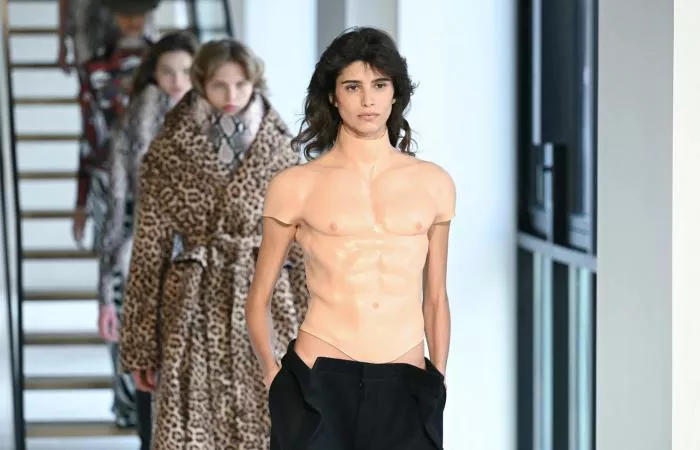From sculpted abs to exaggerated cheekbones, prosthetics are becoming a bold new frontier in fashion. At Paris Fashion Week’s Fall-Winter 2025 show, Dutch designer Duran Lantink turned heads with his avant-garde collection, featuring warped silhouettes, daring animal prints, and jeans with cheeky cutouts. But the real showstoppers were two prosthetic torsos: a hyper-defined six-pack on model Mica Argañaraz and a buxom chest on male model Chandler Frye.
The looks sparked debate online, with some praising the gender-fluid statement and others questioning its intent. For Lantink, it was about playing with the idea of humans as customizable dolls—a theme echoing across runways lately. Brands like Balenciaga, Collina Strada, and Martine Rose have used prosthetics, masks, and 3D makeup to morph models into cyborgs, aliens, and even Kim Kardashian’s infamous silicone curves.
From Medical Aid to Artistic Tool
Prosthetics have come a long way since their origins in ancient Egypt, where wooden toes aided mobility. By the 20th century, they entered entertainment—think horror films and drag performances. Today, advancements in 3D printing and materials like latex have made them more lifelike and versatile.
Special effects artist Malina Stearns, behind Doja Cat’s feline Met Gala look and SZA’s bug-eyed album art, notes the shift: “It’s less about realism and more about artistry.” Meanwhile, drag queen Alexis Stone and visual artist Nadia Lee Cohen have used prosthetics to embody multiple personas, blurring identity lines.
Challenging Norms—Or Just Shock Value?
For some designers, prosthetics critique modern beauty standards. Martine Rose’s fake noses at Milan Fashion Week challenged Eurocentric ideals, while emerging designer Zhongzhi Ding created jeans with prosthetic genitalia for transgender men. Yet, as London College of Fashion’s Tanya Noor points out, “The viral appeal of prosthetics lies in their ability to create ‘scroll-stopping’ moments.”
Collina Strada’s Hillary Taymour sees prosthetics as “a canvas to rewrite the human form.” Her animal-hybrid runway looks aimed to dissolve barriers between humans and nature. But beyond spectacle, could prosthetics evolve into functional fashion? Taymour imagines animatronic designs—”a dress that breathes, a tail that sways.”
For now, prosthetics remain a tool of fantasy, pushing boundaries in an industry obsessed with transformation. Whether making a statement or just a splash, one thing’s clear: fashion’s love affair with artificial enhancement is only beginning.
Related topics:

